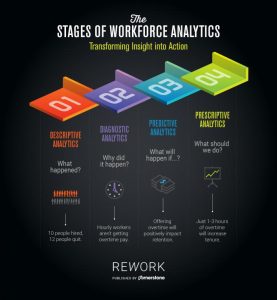When it comes to your HR projects list this year, put workforce analytics first.
The talent management industry has been discussing workforce analytics for years, but 2016 witnessed some of the biggest leaps toward true big data capabilities. Organizations are moving from the simplest stages of workforce data analysis—”descriptive and diagnostic” analytics — to more mature “predictive” analytics. In fact, the percentage of companies that feel fully capable of developing predictive models doubled from 4% in 2015 to 8% in 2016, according to Bersin by Deloitte.
In order to truly provide actionable insights, however, HR teams need to engage in the most advanced form of data analysis: “prescriptive analytics.”
To do this, talent professionals and executives must understand where they currently are on the talent analytics learning curve, and how to mature their analytics capabilities. In order for HR to garner the same respect as finance and marketing when it comes to data-driven insights, teams should aim to advance from simply describing talent problems to actually prescribing solutions for them.
Here are the four stages of workforce analytics and the increasing value each step provides to your organization.

Stages 1 and 2: Describe the problem
When organizations first embark on a workforce analytics journey, the insights are mainly reactive, according to Bersin by Deloitte’s Talent Analytics Maturity Model. These first two stages are known as the “descriptive and diagnostic analytics” phase. The data team’s queries are based on requests from HR or other department leaders, and tend to focus on identifying current talent trends, such as high turnover.
The problem? While descriptive and diagnostic analytics can help you identify current problems your team might be missing, these forms of big data analysis don’t necessarily help you prevent or solve those problems.
Stage 3: Predict the problem
If your organization is already identifying problems thanks to data analytics, then it’s time to think more proactively.
Instead of simply identifying the current state of the workforce, companies can use “predictive analytics” to determine future trends and even test “what-if” analyses in order to understand the impact of decisions before implementing them. For example, an organization might explore the query, “If we added overtime pay, how would that impact turnover?”
Stage 4: Solve the problem
But in order to truly provide actionable insights, organizations should aim to apply the most advanced form of data analysis: “prescriptive analytics.” While predictive analytics provides forecasts for what could happen, prescriptive analytics forecasts what actions should be taken to address those trends, such as finding that just one to three hours of overtime a week increases tenure.
Prescriptive analysis is the most valuable type of data analysis for your organization because it provides actionable, data-backed plans you can present to leadership — representing HR as a truly strategic and influential department.
This article originally appeared on ReWork, a publication exploring the future of work.
